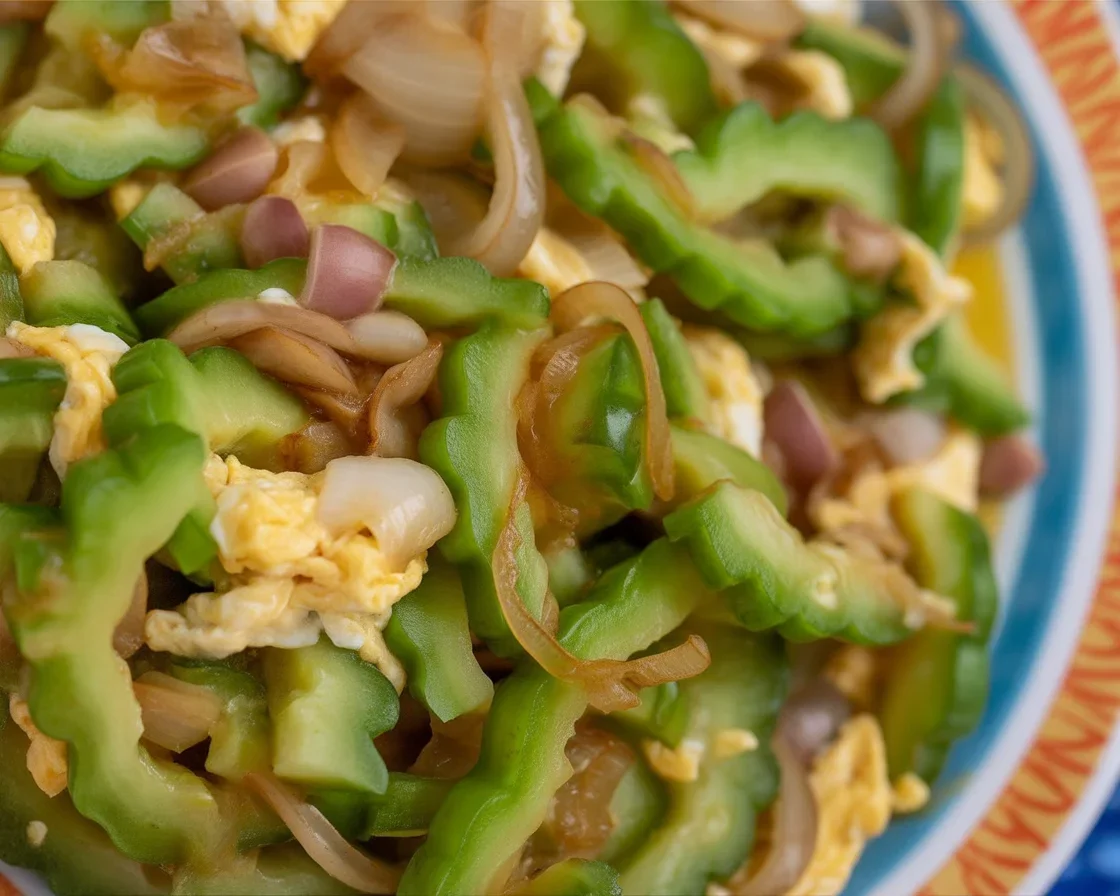- Overview of ginisang ampalaya
- Preparing bitter melon
- Sautéing garlic and onions
- Adding eggs
- Seasoning
- Serving suggestions
- Health benefits
- Common Questions
- Let’s Make Bitter Melon Delicious, Seriously
Filipino ginisang ampalaya is one of those dishes you either love at first bite or wrinkle your nose and come back to it later in life. When I was younger, wow, I used to run away from anything bitter (I mean, why would I CHOOSE to eat something called “bitter melon” on purpose?). Now? Total convert. The way ginisang ampalaya pairs sharp, earthy gourd with creamy eggs just fits. It’s kind of a genius move, honestly. Oh, and if you care about nutrition, this dish checks that box too. You’re interested in healthy Filipino recipes? Or maybe you’re always negotiating at the dinner table with kids—if so, check out these kid-friendly Filipino recipes too.

Overview of ginisang ampalaya
Let’s get this out of the way—Ginisang ampalaya means stir-fried bitter melon with eggs. That’s what it is. Simple stuff. A staple in many Filipino homes, especially when you want something quick and healthy but also, well, not boring. Imagine garlic and onions sizzling up in your favorite pan, then bitter melon slices tossed in and finally that soft scramble of eggs that somehow brings everyone together.
This recipe’s got a reputation. Some folks praise its health benefits, while others—usually kids—make dramatic faces and try to trade their portion for anything else at the table (been there). But if you’re looking for a good-for-you dish that feels authentic and even a bit nostalgic, ginisang ampalaya is the real deal.
I grew up watching my mom make it on busy weeknights. She said if you could cook this, you basically passed Filipino ‘real food’ boot camp. Anyway, I’m here to tell you how to make it matter less if you’re new or a lifelong fan.

Preparing bitter melon
First up, bitter melon (ampalaya) does need some prep love. This is maybe the main thing that puts people off, so here’s the fix: slice the ampalaya thin, scoop out the seeds, then sprinkle a bunch of salt on the pieces and let them sit for like 10 minutes. Don’t skip that salt step! It’s not fancy science—just the old way to reduce the bitterness.
Rinse off all the salt after, then give the pieces a good squeeze. You want them just a bit wilted but not sad and mushy. Trust me. If you know anyone who says ginisang ampalaya is “too bitter,” ask if they prepped it this way. Usually not, and it makes all the difference.
Sometimes, people even soak the bitter melon in cold water after salting. Up to you. I like to eat a little raw slice now and then to see if it’s still super bitter. I always regret that. One day, though, someone will convince me this step isn’t needed—but for now, don’t mess around.

Sautéing garlic and onions
Now for the base of flavor. Don’t rush the garlic and onions—let them get fragrant, a little golden, but not burnt. I use a basic nonstick pan, medium heat, and a healthy glug of oil (some say add tomatoes too, but I don’t do that unless I’m feeling wild).
Here’s the thing: if you want your ginisang ampalaya to comfort and not confront people, this aromatic start is everything. Wait until you can really smell it, almost like someone ELSE is cooking something amazing in your kitchen.
Drop in the prepped bitter melon and let it soften up a few minutes. Not forever. Keep a little crunch. My lola (Filipino grandma) would remind me every time. “Don’t make it slimy!” Etched in my memory now. If she said it, you can trust it.
“Best combo of savory, soft, and just the right touch of bitterness. Made me a believer in vegetables!” – Tess, family friend, perennial skeptic turned fan
Adding eggs
Crack in two or three eggs straight over the softened bitter melon. Some people like to scramble them before adding, but honestly, I just pour ‘em in and swirl gently. Less dishes, more character.
Here’s my tip: don’t fully mix it up right away. Let the eggs set a little, then stir, so you get those pretty patches of yellow and green instead of mush. It helps the egg hold together, wrapping around the ampalaya instead of disappearing completely.
Eggs take, what, a minute, two tops? Once you see them cook through but still soft, you’re golden. If you turn your back and they get hard, well… still edible, but kinda ruins the magic. So pay attention.
Seasoning
Seasoning is where you get to add your soul. A hefty pinch of salt, a few shakes of ground black pepper—taste as you go, seriously. Fish sauce (patis) if that’s your thing, or a dash of soy sauce for an extra layer of yum. If you’re feeling spicy, a little red chili flake never hurt anyone (well, maybe your tongue).
The eggs and ampalaya soak up flavor like crazy, so don’t be shy, but don’t drown it either. I like to add a tiny bit at a time until it just sings. There’s no one-size-fits-all here. And if someone in your house grabs the vinegar bottle? Let ‘em. Filipino families do NOT agree on how to finish this dish. That’s half the fun.
Occasionally I add a whisper of sugar—like, half a pinch—if the bitter melon feels extra mean that day. Not traditional, but hey, kitchen rules were made to be broken some days.
Serving suggestions
Alright, so you’ve got your skillet of ginisang ampalaya ready and steaming. Here’s how we eat it at home:
- With rice, always: I mean, of course.
- Paired with something meaty: Try pork BBQ or bistek if you want more oomph.
- Topped with extra black pepper or chili, if you need a kick.
- It’s actually awesome for breakfast or lunch—works either way.
And if you want even healthier options, peek at these other nutritious Filipino meals for seniors. They might surprise you.
Health benefits
So, obviously, bitter melon is famous for helping manage blood sugar. My tita swears by having this once a week—calls it her “secret medicine.” It’s loaded with fiber, vitamin C, and even some good-for-you antioxidants.
The eggs bring in protein, making it feel like a meal, not just a side. I like that it fills you up but doesn’t weigh you down for hours. Plus, if you check into any classic list of healthy Filipino recipes, ginisang ampalaya will be there.
Last thing—there’s this satisfaction that comes from eating something your childhood self would have run away from. Grown-up wins, right? Anyway, treat yourself.
Common Questions
Why is my ginisang ampalaya so bitter?
You probably skipped the salt and squeeze step, or didn’t rinse it enough. Give it another go—and try slicing thinner, too.
Can I skip the eggs?
You absolutely can. Just follow the same steps and let the ampalaya shine on its own, or try tossing in tofu instead.
What if I don’t have fish sauce?
Salt and a splash of soy sauce work. Fish sauce is classic, but not a deal-breaker at all.
Is this dish good for meal prep?
Totally. Ginisang ampalaya keeps well in the fridge. Some folks even say the flavors deepen after a day. Just reheat gently.
Can kids learn to like this?
It’s honestly worth trying! Sneak in smaller pieces, lighten up the bitterness, and maybe add a splash of tomato for sweetness. You’d be surprised.
Let’s Make Bitter Melon Delicious, Seriously
So, ginisang ampalaya is simple, quick, and far more delicious than its reputation might suggest. Once you salt down that ampalaya and bring it all together with creamy eggs, the magic of Filipino home cooking just shows up, honest. I’ll always love an authentic bistek Tagalog or my mom’s adobo, but there’s a seat at the table for this underdog, too. And hey, if you’re looking for more home-cooked inspiration, check out this full Ginisang Ampalaya Recipe or peek at how others do it over at Ginisang Ampalaya | Filipino Recipe | Foodie Pinoy. Sometimes the classic becomes the new favorite, right? Or, maybe you’ll like the twist with shrimp in this Ginisang Ampalaya at Hipon. Whatever you pick, don’t be shy—try it and let me know if you’re Team Ampalaya yet!

Ginisang Ampalaya
Ingredients
Main Ingredients
- 1 medium bitter melon (ampalaya) Sliced thin and prepped to reduce bitterness with salt.
- 2-3 pieces eggs Cracked directly into the pan.
- 3 cloves garlic Minced.
- 1 medium onion Sliced.
- 2 tablespoons oil For sautéing.
Seasoning
- to taste salt For seasoning and pre-salting the ampalaya.
- to taste black pepper Freshly ground.
- optional fish sauce (patis) For added umami flavor.
- optional soy sauce As an alternative to fish sauce.
- optional red chili flakes For added spice.
- optional sugar A pinch to balance bitterness if needed.
Instructions
Preparation
- Slice the bitter melon thinly, scoop out the seeds, and sprinkle with salt. Let it sit for about 10 minutes to reduce bitterness.
- Rinse the bitter melon and squeeze to remove excess water.
Cooking
- In a nonstick pan, heat oil over medium heat. Add garlic and onions, sauté until fragrant and lightly golden.
- Add the prepped bitter melon and cook for a few minutes until slightly softened but still crunchy.
- Crack eggs directly over the mixture and gently swirl to combine without fully mixing.
- Once the eggs are cooked through but still soft, season with salt, black pepper, and other optional seasonings to taste.
Serving
- Serve hot with steamed rice and enjoy. Optionally, pair with meat dishes or add some chili flakes for extra kick.

